
A History of Oregon Tool, Inc. through the 2000s
THE 2000s: A WINNING COMBINATION
The maverick ways of the 1990s gave way to a millennium of promising new technology that would continue to shape the industry and strengthen the Oregon® brand's product portfolios.
INDUSTRY LEADERS IN NEW TECHNOLOGY
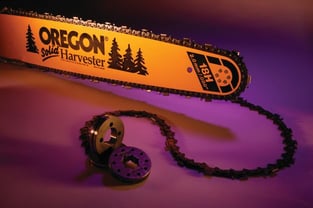 By the early 2000s, the Oregon® brand’s engineers were using state-of-the-art technology to develop innovative, new products that reached further and further into widening markets. The all-new lightweight Power Match® guide bar was one of the first, dramatically reducing the weight of a guide bar for easier operation. For mechanical timber harvesting, the Jet-Fit® harvester bar reduced the time it took to swap out a bar and chain from around ten minutes to about 30 seconds. It did so by way of a patented motor-mount, with slots rather than holes, that could be installed or replaced with ease.
By the early 2000s, the Oregon® brand’s engineers were using state-of-the-art technology to develop innovative, new products that reached further and further into widening markets. The all-new lightweight Power Match® guide bar was one of the first, dramatically reducing the weight of a guide bar for easier operation. For mechanical timber harvesting, the Jet-Fit® harvester bar reduced the time it took to swap out a bar and chain from around ten minutes to about 30 seconds. It did so by way of a patented motor-mount, with slots rather than holes, that could be installed or replaced with ease.
The brand’s product line was also complemented by a variety of new saw chain. This included the 18HX, a durable timber harvester saw chain that reduced the number of changeovers needed by harvester operators; the LPX and LGX logger saw chain, designed for faster speeds in all cutting modes; and the 91VX, which increased speed for smaller saws. The chain itself was enhanced with the introduction of StabL-Link™ drive links, which improved a chain’s overall stability. 
MOWING DOWN THE COMPETITION
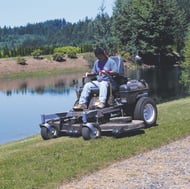 One of the Oregon® brand’s biggest innovations, however, was not intended for timber harvesting but for the lawn and garden industry. After wowing consumers with Gator® blades in the 1990s, the Oregon® engineers improved mower blades once again with their exclusive, patented Fusion® technology, which added an ultra-hard carbonite coating to a blade’s cutting edge. This allowed a blade to stay sharper even longer, giving a clean cut every time.
One of the Oregon® brand’s biggest innovations, however, was not intended for timber harvesting but for the lawn and garden industry. After wowing consumers with Gator® blades in the 1990s, the Oregon® engineers improved mower blades once again with their exclusive, patented Fusion® technology, which added an ultra-hard carbonite coating to a blade’s cutting edge. This allowed a blade to stay sharper even longer, giving a clean cut every time.
On the farm and ranch side of things, the team behind the Woods® brand began the decade by introducing their first single-spindle rotary cutter, the BrushBull™. Intended for heavy duty mowing applications, the BrushBull™ would go on to set the standard for the rotary cutter market. Also in 2000, the Woods® brand obtained a patent for a pin system in which a rotating pin could be adjusted to tighten a cutter blade. This made it easier to assemble and disassemble pivoting blades from a crossbar or other support structure. Later in the decade, the brand’s engineers patented a mowing deck baffle system that improved cut quality by managing airflow.
ANOTHER STELLAR DECADE FOR ICS®
.jpg?width=182&height=275&name=ICS%20scutting%20on%20Mt%20Hood%20(1).jpg) The ICS® brand kicked off the 2000s with a bang, unveiling its newly patented SealPRO® anti-stretch, O-ring technology. SealPRO® solved a key problem for diamond saw chain users. With diamond segments laser-welded to a steel chassis, it locked out the abrasive slurry created when cutting concrete, stone, and masonry. This reduced chain stretch and increased the life of a chain.
The ICS® brand kicked off the 2000s with a bang, unveiling its newly patented SealPRO® anti-stretch, O-ring technology. SealPRO® solved a key problem for diamond saw chain users. With diamond segments laser-welded to a steel chassis, it locked out the abrasive slurry created when cutting concrete, stone, and masonry. This reduced chain stretch and increased the life of a chain.
In 2001, the ICS® brand began marketing its latest high-performance hydraulic saw, the 853PRO. The following year, it introduced the 613GC, a non-hydraulic, gas-powered unit boasting a lower price point and added versatility.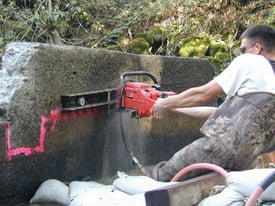
Making a push for new users in 2004, the ICS® brand released its more affordable Redzaw® line of concrete-cutting tools and accessories. This opened the market up for landscapers, masons, and occasional-use general contractors. Offering over 30 products, the Redzaw® sub-brand became a key growth driver.
Business thrived for the rest of the decade. Proprietary revenue for concrete-cutting chainsaws and accessories grew by 25%, with robust growth in replacement parts. Increased product demand called for new manufacturing equipment, and so the brand expanded operations with a new manufacturing and warehouse facility. Global distribution increased by 22%, with over 550 partners and locations around the world.
TITANS OF THE INDUSTRY
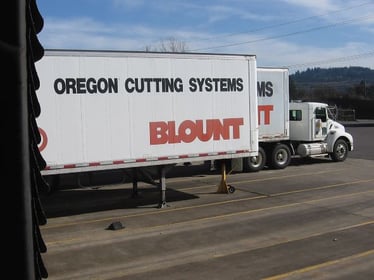 By the beginning of 2002, Blount International, Inc., parent company to both the Oregon® and ICS® brands, had organized its diverse portfolio into two main businesses: industrial equipment and outdoor products. The Oregon® brand alone accounted for three quarters of the company’s Outdoor Products Group, which found itself sustaining record sales and income growth through new business in every major market.
By the beginning of 2002, Blount International, Inc., parent company to both the Oregon® and ICS® brands, had organized its diverse portfolio into two main businesses: industrial equipment and outdoor products. The Oregon® brand alone accounted for three quarters of the company’s Outdoor Products Group, which found itself sustaining record sales and income growth through new business in every major market.
2002 also saw the passing of Joe Cox, inventor of the modern saw chain and founder of the Oregon Saw Chain Corporation, aptly known today as Oregon Tool, Inc. He was 97 years old. Red Blount, founder and former Board Chairman of Blount, Inc., passed away the very same year, at the age of 81. Both men made an immeasurable impact on American manufacturing, and we wouldn’t be the Oregon Tool, Inc. we are today without them.
Blount International, Inc. pressed on, relocating its corporate headquarters to Portland, OR, where it could to be closer to the Outdoor Products Group and the Oregon® brand’s main manufacturing facility. Operational improvements across the board strengthened its two primary businesses, and Jim Osterman, then-President of the Outdoor Products Group, was named President and CEO of the entire company. His former role went to Kenneth Saito, who had been with Blount, Inc. for 29 years.
Leadership in world-class products must be sustained. An environment of continuous improvement, in all we do, will be essential. We must develop innovative new products and grow our existing market segments.
— Kenneth O. Saito
A WINNING COMBINATION
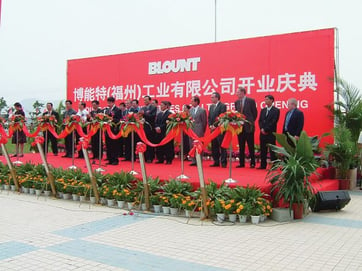 In 2003, the Outdoor Products Group saw a double-digit sales increase, pushing manufacturing capacity to the max. The following year, sales surpassed $400 million for the first time. The group upgraded or introduced over 450 products, the majority of which were under the Oregon® and ICS® brands. To meet demand and remain competitive worldwide, Blount, Inc. began construction on a new, 124,000-square-foot manufacturing plant for Oregon® products in Fuzhou, China, completed in 2005.
In 2003, the Outdoor Products Group saw a double-digit sales increase, pushing manufacturing capacity to the max. The following year, sales surpassed $400 million for the first time. The group upgraded or introduced over 450 products, the majority of which were under the Oregon® and ICS® brands. To meet demand and remain competitive worldwide, Blount, Inc. began construction on a new, 124,000-square-foot manufacturing plant for Oregon® products in Fuzhou, China, completed in 2005.
Despite the challenges of global markets, sales surged to their highest ever recorded. And in 2007, the Oregon® brand marked its 60th anniversary — still the world’s #1 provider of saw chain and an undisputed leader in high-performance cutting tools. Distribution for the brand moved to a new facility in Kansas City, Missouri, where products would be assembled, packaged and stored before being shipped all around the world. In his 48th year with the company, Jim Osterman predicted “a bright but challenging future.” In a speech to the company’s shareholders, he noted the changing nature of economic, technological, and business environments, leaving them with the following sentiment:
We are eager to grow our business in coming years. Our strong portfolio of products and brands, coupled with our outstanding employees, make a winning combination.
— James S. Osterman
In our next chapter, we’ll move ever so closer to the present day and the dawn of Oregon Tool, Inc., when the Woods® brand makes history by joining Blount International, Inc. and teaming up with the Oregon® and ICS.
